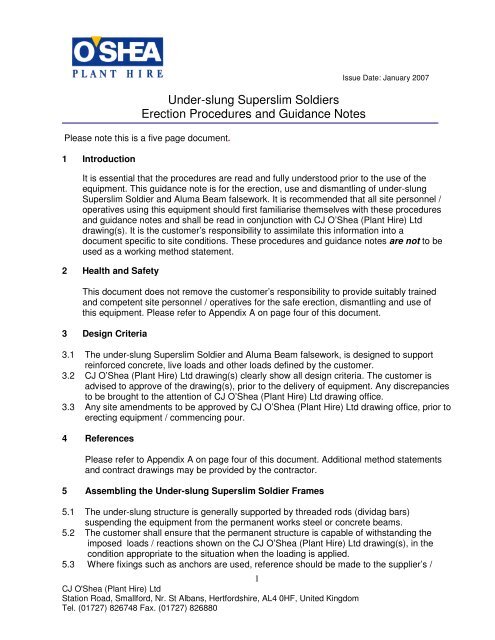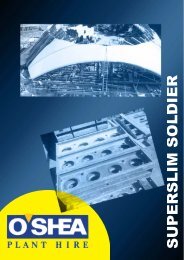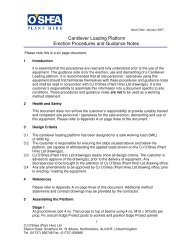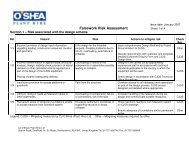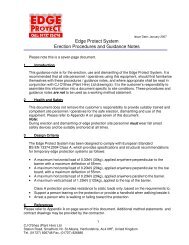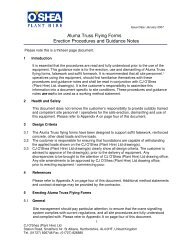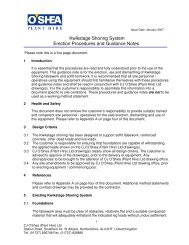Underslung Superslim Beam - CJ O'Shea (Plant Hire)
Underslung Superslim Beam - CJ O'Shea (Plant Hire)
Underslung Superslim Beam - CJ O'Shea (Plant Hire)
You also want an ePaper? Increase the reach of your titles
YUMPU automatically turns print PDFs into web optimized ePapers that Google loves.
Under-slung <strong>Superslim</strong> Soldiers<br />
Erection Procedures and Guidance Notes<br />
Please note this is a five page document.<br />
1 Introduction<br />
1<br />
<strong>CJ</strong> <strong>O'Shea</strong> (<strong>Plant</strong> <strong>Hire</strong>) Ltd<br />
Station Road, Smallford, Nr. St Albans, Hertfordshire, AL4 0HF, United Kingdom<br />
Tel. (01727) 826748 Fax. (01727) 826880<br />
Issue Date: January 2007<br />
It is essential that the procedures are read and fully understood prior to the use of the<br />
equipment. This guidance note is for the erection, use and dismantling of under-slung<br />
<strong>Superslim</strong> Soldier and Aluma <strong>Beam</strong> falsework. It is recommended that all site personnel /<br />
operatives using this equipment should first familiarise themselves with these procedures<br />
and guidance notes and shall be read in conjunction with <strong>CJ</strong> O’Shea (<strong>Plant</strong> <strong>Hire</strong>) Ltd<br />
drawing(s). It is the customer’s responsibility to assimilate this information into a<br />
document specific to site conditions. These procedures and guidance notes are not to be<br />
used as a working method statement.<br />
2 Health and Safety<br />
This document does not remove the customer’s responsibility to provide suitably trained<br />
and competent site personnel / operatives for the safe erection, dismantling and use of<br />
this equipment. Please refer to Appendix A on page four of this document.<br />
3 Design Criteria<br />
3.1 The under-slung <strong>Superslim</strong> Soldier and Aluma <strong>Beam</strong> falsework, is designed to support<br />
reinforced concrete, live loads and other loads defined by the customer.<br />
3.2 <strong>CJ</strong> O’Shea (<strong>Plant</strong> <strong>Hire</strong>) Ltd drawing(s) clearly show all design criteria. The customer is<br />
advised to approve of the drawing(s), prior to the delivery of equipment. Any discrepancies<br />
to be brought to the attention of <strong>CJ</strong> O’Shea (<strong>Plant</strong> <strong>Hire</strong>) Ltd drawing office.<br />
3.3 Any site amendments to be approved by <strong>CJ</strong> O’Shea (<strong>Plant</strong> <strong>Hire</strong>) Ltd drawing office, prior to<br />
erecting equipment / commencing pour.<br />
4 References<br />
Please refer to Appendix A on page four of this document. Additional method statements<br />
and contract drawings may be provided by the contractor.<br />
5 Assembling the Under-slung <strong>Superslim</strong> Soldier Frames<br />
5.1 The under-slung structure is generally supported by threaded rods (dividag bars)<br />
suspending the equipment from the permanent works steel or concrete beams.<br />
5.2 The customer shall ensure that the permanent structure is capable of withstanding the<br />
imposed loads / reactions shown on the <strong>CJ</strong> O’Shea (<strong>Plant</strong> <strong>Hire</strong>) Ltd drawing(s), in the<br />
condition appropriate to the situation when the loading is applied.<br />
5.3 Where fixings such as anchors are used, reference should be made to the supplier’s /
manufacturers current literature for the safe use of the fixings. Any anchor supplier’s<br />
instructions must be adhered to during installation, either on site or previously in pre-<br />
casting situations.<br />
5.4 In some instances, timber packing forms an integral part of the structure. The timber must<br />
be of adequate size and quality to withstand the reaction forces shown on the <strong>CJ</strong> O’Shea<br />
(<strong>Plant</strong> <strong>Hire</strong>) Ltd drawing(s).<br />
5.5 Bolt together the Soldiers in the configuration shown, pay attention to the orientation of<br />
Soldiers such that the internal stiffeners are positioned to enable the fitting of any raking<br />
ties, turnbuckles or horizontal stop brackets. Soldier joints must be in the locations shown<br />
and joint stiffeners used where indicated. Any required deviation from the arrangement<br />
shown must be referred to <strong>CJ</strong> O’Shea (<strong>Plant</strong> <strong>Hire</strong>) Ltd for approval.<br />
5.6 Brace together the Soldiers with tube and fittings as shown to form modules, which can be<br />
crane handled or lifted integrally with the permanent works according to the client’s<br />
method statement. Dismantling will usually be in discrete craned modules per bridge side,<br />
so the horizontal lace tubes must be fitted to allow a small gap between tube ends at<br />
adjacent modules for removal.<br />
5.7 Attach the Aluma <strong>Beam</strong>s to the <strong>Superslim</strong> Soldiers with the clamps specified on the<br />
<strong>CJ</strong> O’Shea (<strong>Plant</strong> <strong>Hire</strong>) Ltd drawing(s), normally one per intersection on staggered sides<br />
of the soldier. These can be fixed either on the ground, or alternatively in situ, in which<br />
case a safe means of access must be provided by the customer.<br />
5.8 Add all plywood-decking, Edge Protect System etc. to complete the structure, fit end<br />
Edge Protect System panels where appropriate.<br />
5.9 Ensure all Edge Protect System panels are arranged in a suitable fashion to enable<br />
dismantling. Any box outs (designed and fabricated by the customer), must be nailed or<br />
screwed to the timber inserts in the Aluma <strong>Beam</strong> secondary bearers, with holes left for<br />
members such as vertical Soldiers and turnbuckles to pass through where necessary.<br />
5.10 Provide and fit all packing shown. Some packing may be designed to prevent the<br />
accidental horizontal movement of the suspending threaded rods.<br />
5.11 The location of the pre-assembled shall be such that it is within the reach and SWL of the<br />
crane. Check the weight of the units prior to lifting either by reference to the <strong>CJ</strong> O’Shea<br />
(<strong>Plant</strong> <strong>Hire</strong>) Ltd data or by trial lifting.<br />
5.12 Sling the unit with a set of four legged chains shortening clutches. Attach via two legs at<br />
the inside of the unit and two legs at the outside of the unit. The approximate centre of<br />
gravity of the unit will be provided if requested by <strong>CJ</strong> O’Shea (<strong>Plant</strong> <strong>Hire</strong>) Ltd.<br />
5.13 Adjust the lengths of the chain legs to ensure slinging is at approximately the correct angle<br />
to allow fixing to the permanent structure. Attach tag lines. Raise the unit into position and<br />
attach the horizontal Soldiers to the bridge structure. Detach the crane and repeat for<br />
other units.<br />
5.14 Complete all handrail infills to provide safe access. Add the equipment shown above the<br />
units. This may include falsework supports, slab or parapet edge formwork etc. Supply,<br />
compress and fit foam filler strip at the joint between the formwork and the bridge structure<br />
to prevent grout loss due to the deflection of the support structure under load.<br />
6 Use of Under-slung <strong>Superslim</strong> Soldier Frames<br />
6.1 Access<br />
Access must be designed and provided by the customer, with safety harnesses used<br />
where erectors work outside completed personnel access areas.<br />
2<br />
<strong>CJ</strong> <strong>O'Shea</strong> (<strong>Plant</strong> <strong>Hire</strong>) Ltd<br />
Station Road, Smallford, Nr. St Albans, Hertfordshire, AL4 0HF, United Kingdom<br />
Tel. (01727) 826748 Fax. (01727) 826880
6.2 Loading<br />
Prior to loading, check the equipment has been assembled as per the <strong>CJ</strong> O’Shea<br />
(<strong>Plant</strong> <strong>Hire</strong>) Ltd drawing(s). Ensure that all connections are sound, and that suspending<br />
threaded rods and nuts are tightened. Ensure all Edge Protect System panels are<br />
tightened. Make any adjustments as necessary.<br />
Consult the <strong>CJ</strong> O’Shea (<strong>Plant</strong> <strong>Hire</strong>) Ltd drawing(s) for any specific loading requirements<br />
and issue a Permit to Load document to site operatives.<br />
6.3 Concreting<br />
Fix the reinforcement and complete all formwork. Place the concrete evenly avoiding<br />
heaping. Allow curing.<br />
7 Dismantling the Under-slung <strong>Superslim</strong> Soldier Frames<br />
Erect the permanent works parapet handrail or Edge Protect System to provide safe<br />
access once the parapet falsework has been removed. Strike and remove the formwork<br />
and any falsework above the under-slung modules. Provide safe means of access to<br />
enable subsequent dismantling operations.<br />
8 Removing as a Module<br />
Centre of Gravity of the Under-slung Module Out of the Cast Parapet<br />
Attach the slings as for erection, take the weight of the unit on the crane. Remove the<br />
fixings to the permanent structure and any connections with neighbouring units. Fix tag<br />
lines. Part the falsework module from the deck. Lower the unit to the ground for inspection<br />
and maintenance prior to any re-use.<br />
Centre of Gravity of the Under-slung Module Inside the Cast Parapet<br />
Use a designed C-Hook to lower the module. Position the C-Hook under the module. Take<br />
the weight of the unit of the crane. Remove the fixings to the permanent structure and any<br />
connections with neighbouring units. Fix tag lines. Part the formwork module from the<br />
deck. Lower the unit to the ground for inspection and maintenance prior to any re-use.<br />
Dismantle the units in reverse order to assembly, removing the scaffolding, the vertical<br />
part of the structure and then the box out and ply deck. The Aluma <strong>Beam</strong>s are then<br />
unclamped and the soldier sections unbolted.<br />
9 Lowering Piecemeal<br />
Working from a suitable access such as a cherry picker/scissors lift or working with a<br />
safety harness suitably attached, dismantle the under-slung falsework piecemeal.<br />
9.1 Work from the top and strip off the toe boards, plywood decking, Aluma <strong>Beam</strong>s,<br />
Edge Protect System panels and any vertical Soldiers. Stack dismantled components<br />
neatly in the appropriate containers / stillages on the completed deck.<br />
9.2 Working from underneath, remove the scaffold tube bracing. Attach slings to any Soldiers<br />
that can be crane handled and take the weight. Undo the end connections and lower to<br />
3<br />
<strong>CJ</strong> <strong>O'Shea</strong> (<strong>Plant</strong> <strong>Hire</strong>) Ltd<br />
Station Road, Smallford, Nr. St Albans, Hertfordshire, AL4 0HF, United Kingdom<br />
Tel. (01727) 826748 Fax. (01727) 826880
the ground.<br />
9.3 Working on the shortest lengths of Soldiers possible, remove the fixings to the permanent<br />
structure and any connections and lower onto the temporary access platform. Transfer to<br />
ground level.<br />
9.4 Clean and place the dismantled components in the supplied stillages, and return the<br />
equipment to <strong>CJ</strong> O’Shea (<strong>Plant</strong> <strong>Hire</strong>) Ltd.<br />
10 Making Good<br />
Make good the holes left by removal of the threaded rods. Access can be provided from<br />
scaffolding, cherry picker or scissors lift working from below, or an under-bridge inspection<br />
unit working from above.<br />
Appendix A - References<br />
1. Legislation<br />
The Work at Height Regulations 2005<br />
Lifting Operations and Lifting Equipment Regulations 1998<br />
Provision and Use of Work Equipment Regulations 1998<br />
Personal Protective Equipment at Work Regulations 1992<br />
Management of Health and Safety at Work Regulations 1999<br />
Construction (Design and Management) Regulations 1994 (as amended)<br />
Construction (Health, Safety and Welfare) Regulations 1996<br />
The Control of Noise at Work Regulations 2005<br />
2. HSE Approved Codes of Practice and Guidance<br />
L22 Safe use of Work Equipment ACOP and Guidance<br />
L113 Safe use of Lifting Equipment ACOP and Guidance<br />
HS(G)150 Health and Safety in Construction<br />
HS(G)151 Protecting the Public – Your Next Move<br />
CIS17 Construction Health and Safety Checklist (Rev.1996)<br />
CIS49 General Access Scaffolds and Ladders 1997<br />
IND(G)220 A Guide to the Construction (Health, Safety and Welfare Regs. 1996)<br />
3. Guidance<br />
Concrete Society: Formwork a Guide to Good Practice<br />
Construction <strong>Plant</strong> <strong>Hire</strong> Association (CPA): British Concrete Pumping Group:<br />
Concrete Pump Operators’ Safety Guide<br />
Code of Practice for the Safe Use of Concrete Pumps<br />
Construction Industry Research and Information Association:<br />
Report 108: Concrete Pressure on Formwork<br />
Timber Research and Development Association:<br />
Simplified rules for the Inspection of Second-hand Timber for Load Bearing Use<br />
Precast Concrete Frame Association:<br />
Code of Practice for the Safe erection of Precast Concrete Frameworks<br />
Concrete Structures Group:<br />
A guide to the safe transportation of formwork and falsework equipment<br />
4. Standards<br />
BS 1129 Portable Timber Ladders, Steps, Trestles and Light-weight Stagings<br />
BS 2037 Aluminium Ladders Steps and Trestles<br />
<strong>CJ</strong> <strong>O'Shea</strong> (<strong>Plant</strong> <strong>Hire</strong>) Ltd<br />
Station Road, Smallford, Nr. St Albans, Hertfordshire, AL4 0HF, United Kingdom<br />
Tel. (01727) 826748 Fax. (01727) 826880<br />
4
BS 2482 Timber Scaffold Boards<br />
BS 5531 Safety in Erecting Structural Frames<br />
BS 5975 Code of Practice for Falsework<br />
BS 6180 Protective Barriers in and about Buildings<br />
BS EN 131 Part 1 and 2: Ladders<br />
BS EN 361 Full Body Harness<br />
BS EN 1570 Safety Requirements for Lifting Tables<br />
BS EN 1263 Safety Nets<br />
BS EN 12811 Temporary Works Equipment<br />
BS EN 12811-1:2003 Scaffolds – Performance Requirements and General Design<br />
BS EN 12812 Falsework Performance Requirements and General Design<br />
BS EN 13374:2004 Temporary Edge Protection Systems – Product Specification, Test Methods<br />
CP 118 The Structural Use of Aluminium<br />
5. Manufactures Technical Data<br />
References should be made to the following Technical Data, available from <strong>CJ</strong> O’Shea (<strong>Plant</strong> <strong>Hire</strong>) Ltd.<br />
<strong>Superslim</strong> Soldiers<br />
Aluma <strong>Beam</strong>s<br />
5<br />
<strong>CJ</strong> <strong>O'Shea</strong> (<strong>Plant</strong> <strong>Hire</strong>) Ltd<br />
Station Road, Smallford, Nr. St Albans, Hertfordshire, AL4 0HF, United Kingdom<br />
Tel. (01727) 826748 Fax. (01727) 826880


